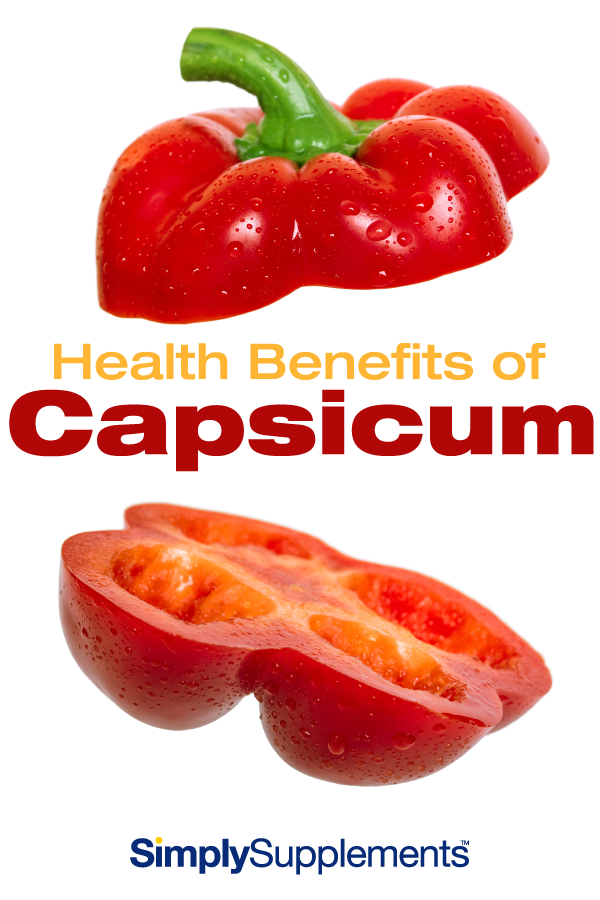Capsaicin Vitamin C
Capsicum is the name given to the pepper family, which contain a variety of different species all the way from the peppers with zero heat, such as bell peppers, to the hottest of peppers such as the Ghost Chilli or the Carolina Reaper!
Peppers, which are native to the Americas, are now grown all over the world due to their versatility, taste, and health benefits. One of the reasons that capsicums have received so much attention in both the scientific community and the media in recent years is because of the nutrients they contain.
Please carry on reading to learn all about peppers and what they can do for your health…
What Are the Benefits of Capsicum?
Although there are many different types of peppers, they all have a lot of in common.
Vitamin A
Did you realise that red peppers are just ripened green peppers? It is also known that the nutrient composition of the peppers changes with colour. For example, green bell peppers contain around 10% of the vitamin A content of red bell peppers, with one medium red bell pepper providing over a third of the Nutrient Reference Value (NRV).
It is well-known that vitamin A is crucial to healthy vision, good immune function, vibrant skin, and protecting the body from oxidative stress. Vitamin A is also needed for the body to effectively absorb and utilise the iron obtained from the diet. Currently, the NRV for vitamin A is set at 0.8mg per day.
Vitamin C
 Not many people realise that red and yellow bell peppers are a superior source of vitamin C to oranges, with the yellow variety containing a massive 184mg per 100g and their red relatives providing 128mg. This dwarfs the 53mg that is provided in 100g of orange.
Not many people realise that red and yellow bell peppers are a superior source of vitamin C to oranges, with the yellow variety containing a massive 184mg per 100g and their red relatives providing 128mg. This dwarfs the 53mg that is provided in 100g of orange.
It is universally known that vitamin C, otherwise known as ascorbic acid, is crucial for good immune function, helping us fight off illnesses and infections. Vitamin C is especially important for those who exercise regularly, as the body experiences a suppressed immune system during and after exercise bouts.
However, many of vitamin C's other roles may not be as well known. Vitamin C is also needed for metabolism, psychological function and to help reduce feelings of tiredness and fatigue. Furthermore, vitamin C has a key role in the formation of collagen, which is a protein that provides structural integrity in the body. Specifically, vitamin C promotes the collagen formation which helps to keep the skin, gums, teeth, bones, blood vessels and joint cartilage healthy.
Due to all these benefits it is clear to see why vitamin C is so important, and thus why bell peppers are so popular! Currently, the European Commission have set the NRV for vitamin C at 80mg per day. However, there may be times where a greater amount is needed, such as during illness.
Although peppers are best known for their vitamin A and C content, they also contain appreciable amounts of other nutrients which are deemed essential for the body, such as vitamins B6, B9 and E, as well as molybdenum.
Health Benefits of Capsaicin
You may have heard of the measurement called Scoville units, which was developed by Wilbur Scoville to quantify how hot a chilli pepper is. Bell peppers have a Scoville rating of zero, whereas the Guinness book of records currently has the Carolina Reaper as the hottest pepper in the world with an average Scoville rating of 1,569,300, with one of the peppers they tested hitting 2.2 million!
Capsaicin is the active ingredient in peppers that is responsible for giving them their spicy kick, with the heat of the pepper proportional to their capsaicin concentration. It comes as no surprise then that bell peppers have no capsaicin. This is in stark contrast to the Carolina Reaper chilli which is around 15% pure capsaicin!
Apart from being an irritant to the mouth, and having the capacity to bring a grown man to tears, capsaicin has been shown in research to have numerous health benefits.
Osteoarthritis
 Osteoarthritis is by far the most prevalent type of joint disease, affecting the lives of nearly 9 million people in the UK alone. Osteoarthritis can occur all over the body, but is most commonly seen in knees, hips and the lower back.
Osteoarthritis is by far the most prevalent type of joint disease, affecting the lives of nearly 9 million people in the UK alone. Osteoarthritis can occur all over the body, but is most commonly seen in knees, hips and the lower back.
Because of the prevalence and severity of osteoarthritis, there is considerable interest in ways to manage symptoms. One which has shown great promise in clinical investigations is capsaicin, which is frequently applied topically to problematic areas to relieve pain.
A meta-analysis conducted in 1994 found that a capsaicin gel, applied four times per day was four times as effective as a placebo gel at improving symptoms of pain and joint tenderness. Meta-analysis studies are widely regarded as the gold standard of scientific evidence, as they collate the results of numerous smaller studies to provide a consensus on the current literature. Even though this study only analysed 3 investigations, the results were clear that capsaicin potently reduced the symptoms.
Another study conducted shortly after the above review reinforces the findings. In 113 participants, it was found that applying a capsaicin gel 4 times daily for 12 weeks led to a significant improvement in symptoms in 81% of them.A further study published in 2000 confirmed these results, with 6 weeks of treatment leading to significant reductions in pain and stiffness in 36 people with osteoarthritis. This allowed many of the participants to drastically reduce their use of painkillers.
Because of this clear-cut evidence, Arthritis Research UK currently scores capsaicin as 5/5 for effectiveness for treating this condition. They have also given it a safety classification of green. For reference, the other best natural remedies for osteoarthritis are ginger, green lipped mussels and rosehips with scores of 3/5 for effectiveness.
Appetite Reduction
Latest statistics with regards to the prevalence of weight issues in the UK population make for grim reading, as over 60% of us are overweight (a BMI of 25-29.9), with over a quarter of those being classed as obese (BMI of over 30). Because of these alarming statistics there is obviously a lot of interest in ways to manage our weight. One of the most effective ways to do this is to curb our hunger pangs, as a decreased desire to eat often leads to a lower calorie intake.
Preliminary research into capsaicin has shown that in healthy men, the administration of 750mg per day led to a significant drop in appetite, which resulted in less calories and fat being consumed.
Further research has confirmed these findings, as investigations have found that capsaicin intake can lead to a reduced desire to eat fatty foods, sweet foods, salty foods and the general desire to eat. Studies have shown capsaicin can decrease concentrations of a hormone called ghrelin, which is known to make us feel hungry. It can also lead to an increase in GLP-1, a hormone that makes us feel full.
Although this research is promising, most of it has been conducted in lean and healthy individuals. Hopefully future studies will assess the impact of capsaicin in overweight and obese individuals who could see real health benefits from a reduced calorie intake.
Increase in Metabolism
If one side of the energy balance equation is energy going in, then the other side is energy going out. One way to ensure we stay a healthy bodyweight is by increasing the number of calories we expend.
We have all heard of foods that have 'fat burning' properties that speed up our metabolism, and the idea is obviously very attractive to many. Unfortunately, most of the research to underpin these claims is lacking. However, chilli peppers that contain capsaicin have been shown in numerous high-quality studies to be able to increase metabolic rate, fat burning and weight-loss.
In one study, it was found that the provision of 135mg of capsaicin per day led to a significant increase in fat burning in comparison to the group who received a placebo. The Dutch researchers also found that the capsaicin led to an increase in metabolism by an average of 120 calories per day.
Another study from 2009 found that over a 12 week period, daily capsaicin supplementation led to a greater reduction in weight loss and also abdominal fat when compared to the placebo. Abdominal fat mass is thought to be such a serious health concern as this is the fat which surrounds vital organs such as the liver, kidneys and pancreas.
Although these improvements were modest, it is important to note that these individuals did not increase their exercise levels or purposefully reduce their energy intake. So in all likelihood, greater improvements would have been seen with these positive lifestyle changes.
Although there are some studies which have found no benefit to appetite, fat loss and metabolism from capsaicin provision, the results on the whole are promising. It must be said that capsaicin is not a solution to obesity, nor is it going to compensate for a sedentary lifestyle and poor dietary practices. However, when combined with a calorie-controlled diet and regular exercise, it could lead to modest but impressive reductions in weight which is greater than exercise and diet alone could stimulate.
How Much Capsicum Should I Take?
 The best way to obtain all the health benefits of peppers is from including them in your diet. A few slices in a wrap, or including them in soups or stir-fries would be an easy way to obtain their natural qualities. The World Health Organisation currently class one portion of fruit/vegetables as 80g, which is roughly half of a large bell pepper.
The best way to obtain all the health benefits of peppers is from including them in your diet. A few slices in a wrap, or including them in soups or stir-fries would be an easy way to obtain their natural qualities. The World Health Organisation currently class one portion of fruit/vegetables as 80g, which is roughly half of a large bell pepper.
With regards to capsaicin cream/gel for helping to treat the symptoms of osteoarthritis, the current research suggests that a capsaicin concentration as small as 0.025 to 0.075% has been effective.
Providing a figure for the most effective dose of capsaicin is unfortunately very challenging at this stage due to numerous factors. Firstly, studies have regularly used doses which are vastly different. Secondly, natural sources of capsaicin from peppers can vary greatly, meaning that researchers are often unsure of the exact capsaicin concentrations. Thirdly, the side effects from the capsaicin in some people led to them not achieving the stated daily dosage.
Some studies have used as little as 0.2mg of capsaicin all the way up to 750mg of pure capsaicin in capsule form. However this higher dosage is likely to cause side effects, especially in those unaccustomed to spicy food. Future research should look to uncover the minimal effective dose, which will hopefully be sustainable for people to take regularly.
What Are the Side Effects of Capsicum?
Due to the natural properties of capsicum, these peppers are going to provide essential nutrients and also phytochemicals that are beneficial to health. So unless you have an allergy, regularly incorporating peppers of all kinds can only be a good thing.
That being said, capsaicin supplements or peppers with high levels of capsaicin can have some side effects. As capsaicin is an irritant, it causes a burning sensation in the mouth and stomach, and can also lead to gastrointestinal issues. For many participants in research studies, the side effects have been overwhelming and led to many not taking the instructed dosage. Unfortunately because of this, many people may not be able to obtain the benefits of capsaicin due to the side effects.
However, there is some encouraging evidence. Capsiate, which is a non-spicy molecule very similar to capsaicin, has been shown in preliminary research to have positive effects on fat loss without side effects. Future research will hopefully reinforce these findings.
In the same vein, capsaicin gels for the treatment of osteoarthritis can also cause burning sensations. In the 1994 study which was cited earlier, 46% of the subjects reported mild to moderate burning sensations following the application of the cream. However due to the large improvement in symptoms, this trade-off will likely be worth it for many who suffer with osteoarthritis.
Summary
Peppers are such a popular part of many people's diets due to their taste and versatility. Hopefully this article has shown that peppers (especially the spicy ones) are much more than a tasty addition to our meals, given their impressive nutritional profile.
Take home points:
• Capsicum is the name of the family of peppers, all the way from non-spicy salad peppers to the hottest of chillies.
• Peppers are a great source of vitamins A & C, but also contain a variety of other essential nutrients.
• Capsaicin is the molecule responsible for the heat of peppers, with the hottest peppers having the most capsaicin. The heat of chillies is often measured in Scoville units.
• Capsaicin in the form of a gel has consistently shown to reduce symptoms of osteoarthritis when applied topically. This has led to Arthritis Research UK labelling it the most effective complementary medicine with a safety classification of green.
• Capsaicin could also have a role in weight management, as research has consistently shown its ability to reduce appetite sensations, calorie intake and also increase metabolic rate, fat burning and weight-loss.
• Unfortunately, many people do not reap the benefits of capsaicin as the burning side effects lead to people reducing, or totally stopping their intake.
• Preliminary research has shown that a very similar molecule called capsiate can offer the same benefits of capsaicin without the burning sensations. Future research will hopefully confirm these findings so those looking to become a healthy weight can benefit from this alongside a good diet and regular exercise.

Sources:
https://www.ncbi.nlm.nih.gov/pubmed/7995318
https://www.researchgate.net/publication/256921552_Capsaicin_cream_0025_as_Monotherapy_for_Osteoarthritis_A_double-blind_study
https://www.ncbi.nlm.nih.gov/pubmed/11124007
https://www.arthritisresearchuk.org/arthritis-information/complementary-and-alternative-medicines/cam-report/complementary-medicines-for-fibromyalgia/capsaicin.aspx
https://www.arthritisresearchuk.org/arthritis-information/complementary-and-alternative-medicines/cam-report.aspx
https://www.ncbi.nlm.nih.gov/pubmed/15182402
https://www.ncbi.nlm.nih.gov/pubmed/13129472/
https://www.ncbi.nlm.nih.gov/pubmed/19056576
https://www.ncbi.nlm.nih.gov/pmc/articles/PMC3257466/
Source: https://www.simplysupplements.co.uk/healthylife/supplements/capsicum-capsaicin-benefits








Tidak ada komentar:
Posting Komentar